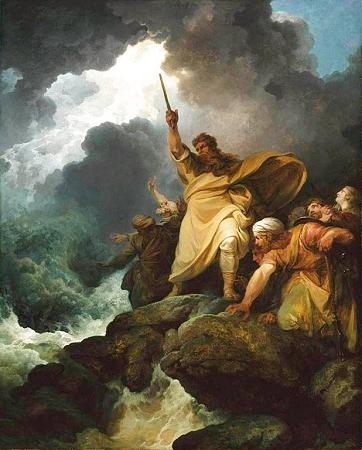
Philippe Jacques de Loutherbourg. Philip James de Loutherbourg, whose name is sometimes given in the French form of Philippe-Jacques, the German form of Philipp Jakob, or with the English-language epithet of the Younger, was a Franco-British painter who became known for his large naval works, his elaborate set designs for London theatres, and his invention of a mechanical theatre called the Eidophusikon.
He also had an interest in faith-healing and the occult and was a companion of the confidence-trickster Cagliostro. Loutherbourg was born in Strasbourg in 1740, the son of an expatriate Polish miniature painter.
Intended for the Lutheran ministry, he was educated at the University of Strasbourg. Rejecting a religious calling, Loutherbourg decided to become a painter, and in 1755 placed himself under Charles-André van Loo in Paris and later under Francesco Giuseppe Casanova.
His talent developed rapidly, and he became a figure in the fashionable society of the day. In 1767 he was elected to the French Academy, although below the age required by the rules of the institution, and painted landscapes, sea storms, and battles, all of which work had a celebrity above those of the specialists then working in Paris.
He made his debut with the exhibition of twelve pictures, including Storm at Sunset, Night, and Morning after Rain. Loutherbourg then travelled through Switzerland, Germany and Italy, distinguishing himself
He also had an interest in faith-healing and the occult and was a companion of the confidence-trickster Cagliostro. Loutherbourg was born in Strasbourg in 1740, the son of an expatriate Polish miniature painter.
Intended for the Lutheran ministry, he was educated at the University of Strasbourg. Rejecting a religious calling, Loutherbourg decided to become a painter, and in 1755 placed himself under Charles-André van Loo in Paris and later under Francesco Giuseppe Casanova.
His talent developed rapidly, and he became a figure in the fashionable society of the day. In 1767 he was elected to the French Academy, although below the age required by the rules of the institution, and painted landscapes, sea storms, and battles, all of which work had a celebrity above those of the specialists then working in Paris.
He made his debut with the exhibition of twelve pictures, including Storm at Sunset, Night, and Morning after Rain. Loutherbourg then travelled through Switzerland, Germany and Italy, distinguishing himself
Wikipedia ...